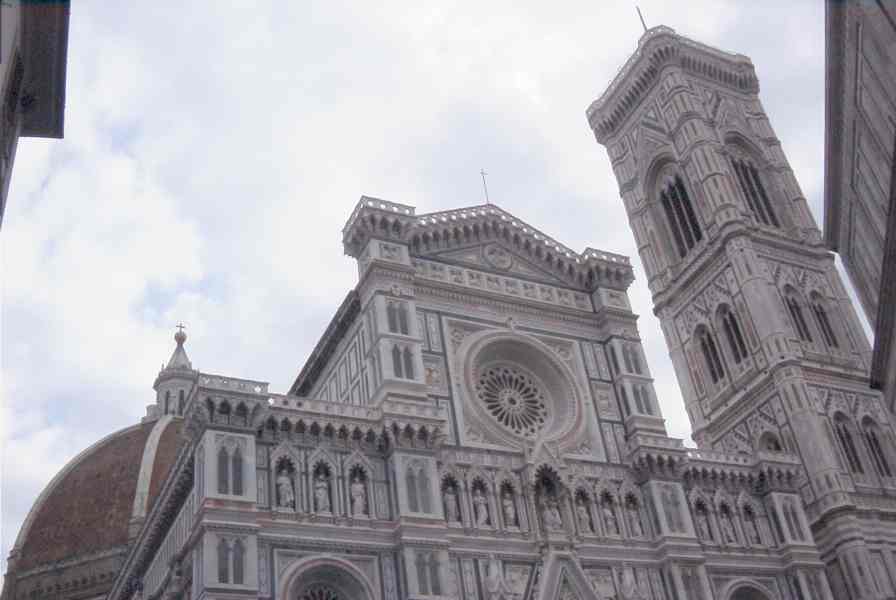

Scholars still marvel that this small city of moneylenders and cloth-makers without much political or military power rose to a position of enormous influence in Italy, Europe, and beyond. The Florentine vernacular became the Italian language; and the local coin, the florin, became a world monetary standard. Florentine artists formulated the laws of perspective; Florentine men of letters, painters, architects, and craftsmen began the period known as the Renaissance; and a Florentine navigator, Amerigo Vespucci, gave his name to two continents...from the Encyclopædia Britannica
We arrived in Florence after a most unusual Air France flight:
Turns out the flight back was nearly the same in terms of efficiency--but bilingual. By that time we didn't mind the food as six days on a tuscan restaurant diet more than distracted us from our withdrawal from French cuisine for the six days.
Once at the airport, a pleasant taxi driver interrupted his reading, greeted us in impeccable English, played classical (I hope baroque) music for us, and proceeded to give us a tour of Florence on the way to our hotel in the garden area of Florence. (Liberal arts majors, be aware that renaissance men even in Florence end up driving cabs!) Despite it being only 10AM, the hotel had our spacious room ready. All-in-all, it was the best opening we've had to a trip in ages. We were beginning to think we were geniuses for risking a November vacation. However, even geniuses keep umbrellas in their backpacks.
Armed with the hotel map, we started the northward trek (mostly downhill through walled streets) over the only bridge the Germans didn't blow up on their way out of town in 1944 (the Pont Vecchio) over the Arno and into town. Our destination was cathedral square, pretty much ground zero for the Renaissance. (More on that later). After a quick lunch, we were presented with the façade below:

Since the cathedral was started in 1296, you would think that we'd be seeing some pretty old marble here. In fact, the façade was added in the "neo" Gothic style in 1871-87, so we were pretty much looking at a church that took 600 years to build. (Did you want speed or accuracy? Except for the façade, the rest of the place was finished in about 170 years, still no speed record).
We found unfinished fronts to be typical of Florence churches; facades would be added years later or often, not at all. More often than not, we would approach unfinished church fronts, walk through the doors, and be surrounded by late Gothic, Renaissance, or Baroque beauty. Our taxi driver claimed the church fronts were left unfinished because the state only taxed churches once they were completed -- so the cheap congregation always left the front undone. Guide books claim that the church committees can't make up their minds on what the front should look like and so let the decision be left to future generations.
Scale to the Victors
|
Does size matter? Tuscany was playing Texas in the late 13th century. It figured that since it was the greatest city in the world, it should have the biggest cathedral. It did until Rome put up St. Peters around a couple hundred years later (with a Florence guy called Michelangelo as architect). In fact, Florence's cathedral is only marginally bigger than St. Paul's in London as the English had a pretty good opinion of themselves at that time. But today Florence has still the fourth largest church in the world. (Americans, of course, worship other gods and we wouldn't think of mentioning the University of Michigan Football Stadium in Ann Arbor which at least has the sense to lack a dome unlike other spaces dedicated to this sport.) If you stay with us, you'll see that the good people of Sienna tried to make their cathedral even bigger but were plagued with difficulties. (If you got that last pun, you've been to Sienna; if not, don't worry, I will probably use it again on the Sienna page, given the extremely low humor standards at work on these pages). |
In the budHere's a closer-up of the front of the Cathedral which the Italians call a Duomo (probably from the Latin "house of god": Dominus Deo). This façade is neo-Gothic and the snooty people who write guidebooks don't care much for it. In fact, with the use of the white, green, and pink marble, it matches the "look and feel" of the tower next to it fairly well even though the tower lacks the niches with statues of Mary and the apostles. (As you know, systems ' standards on art are pretty low and some of us even thought Windows 3.0 looked good.) Due to the angle on the picture above, you're looking at only the center of three Rose windows. We'll see it from the inside in another minute (depending upon your modem speed). This Duomo is dedicated to Santa Maria del Fiore, "Saint Mary of the Flower" with the flower probably being Christ, a true budding genius if there ever was one. Front manThe cathedral was built around a much more modest church called Santa Reparta. Since it takes years (centuries sometimes) to build a gothic cathedral, the earlier building is often used in the meantime; Florentines walked through the new façade for 70 years to worship in Santa Reparta before they completed enough of the new cathedral to tear Santa Reparta down inside of it. (Yes, it did have an unfinished gothic façade but the duke had it torn down in 1587 so that an appropriately high renaissance front could be added. He died before he funded the reconstruction. The "unfinished" Gothic front torn down had some major league statues in it, including several by Donatello .) |
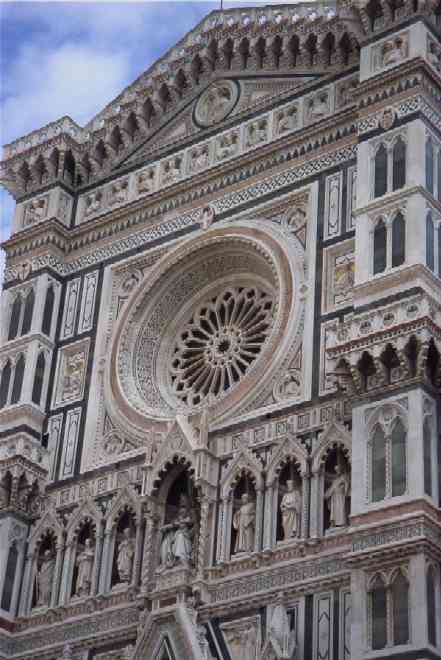 |
Enter through the doors with us to check out the inside. To help you get a sense of the size of these doors, I asked a Florence fashion model (in red coat below) to pose in front of them:
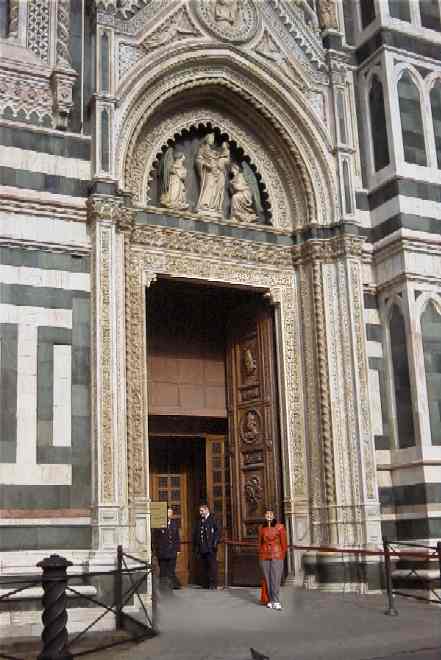
Inside, the cathedral was much more sparse than we expected, given the elaborate exterior.
Below is the tiled marble floor (you don't see this on entering, I took this shot from the dome later on during the visit. You're looking towards the west wall, the traditional front of the cathedral.)
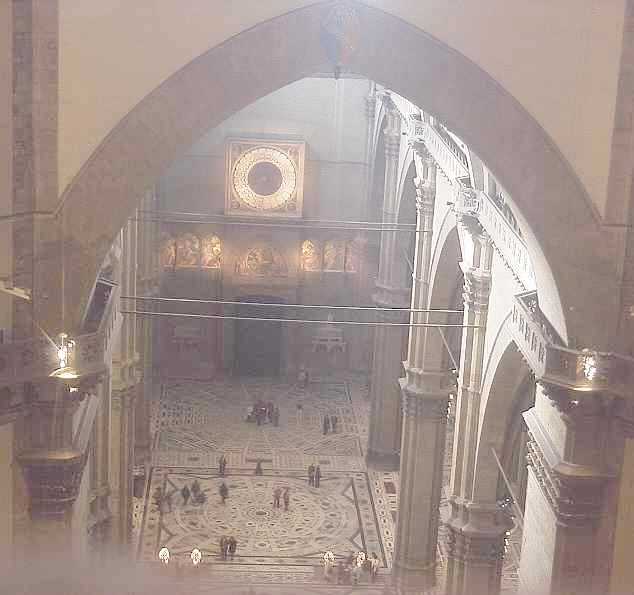
With the sun still high in the sky, the natural thing was to look backward to get its impact through the west façade rose windows (The Duomo has three of them on the West end but I only could get one in) underneath the vaulting.
The 44 stain glass windows make up the most extensive collection in 14th and 15th century Italy.
The interior west wall, of course, was built first as the people walked through it for 70 years into the old church. They wanted to see a little decoration during that time, since most of them would die long before the cathedral looked like much. Artists complied with Christ crowning Mary a Mosaic by Gaddo Gaddi.
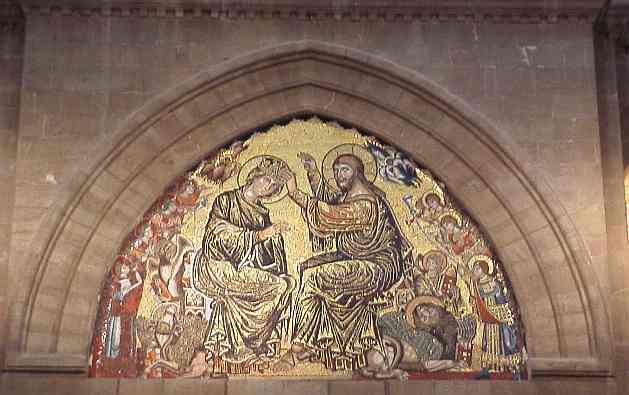
…under a most unusual clock painted by Paolo Uccellowho was obsessed by perspective, a recent renaissance invention when he painted the clock:
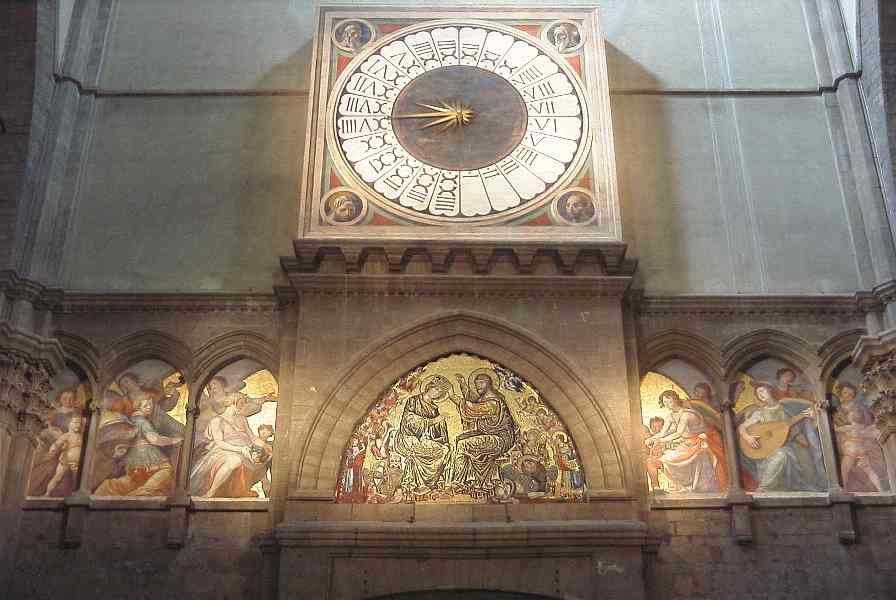
The clock has 24 hour markings and keeps church time: from sunset the on the eve of a feast day through the next day. Each corner is adorned by a head of a prophet.
While we're at it, here's a couple other stain glass pictures. The one on the left is from the side aisle -- 14th century vintage. I'm not sure where the circular one sits:
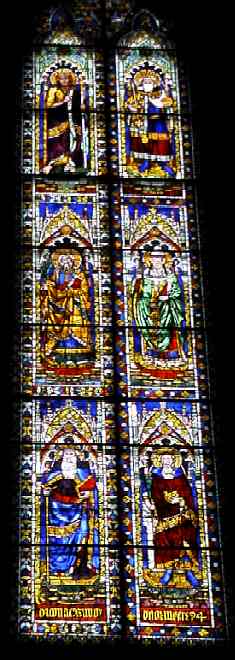
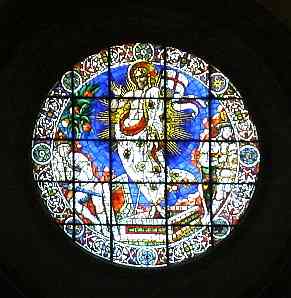
We strolled down to the transept of the church, under the magnificent dome and I took my one picture with the tripod that I had dragged all the way from Paris. Here it is:
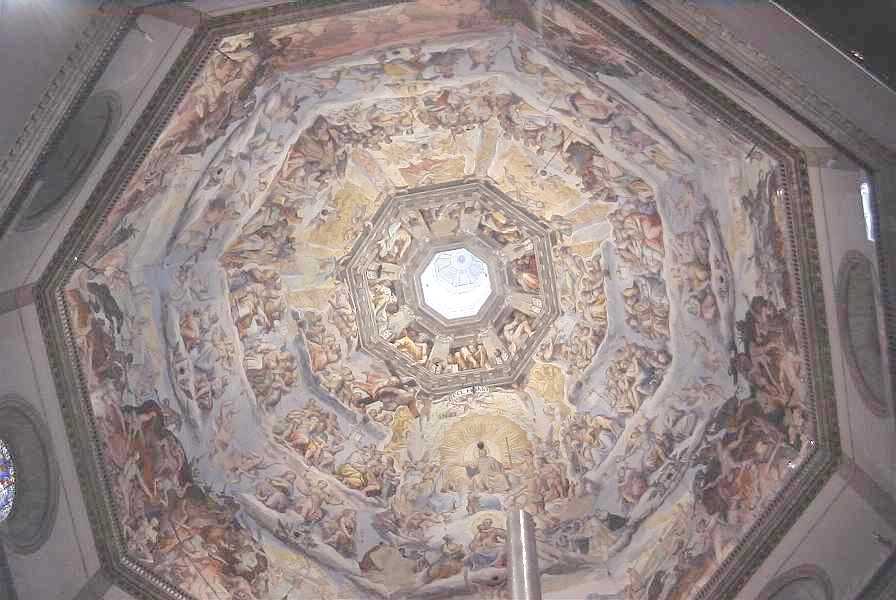
I suppose the no tripod rule (which I immediately learned after taking this picture) is meant to help with crowd control during the packed summers. This was November and we just about had the transept to ourselves.
We'll see a lot more of this massive inner dome picture close-up later. If it looks like the last judgement to you, then you have good eyes (or are feeling very guilty abut something). If that spot in the middle reminds you of the Oculus in the Pantheon in Rome (my favorite building), then you're on to how Brunelleschi solved the problem of how to cover this huge hole. (We'll get to that on our dome page).
Passing beyond the the transept, one sees the beautiful screen that surrounds the altar centered under the dome. These are only a three figures from dozens of marble
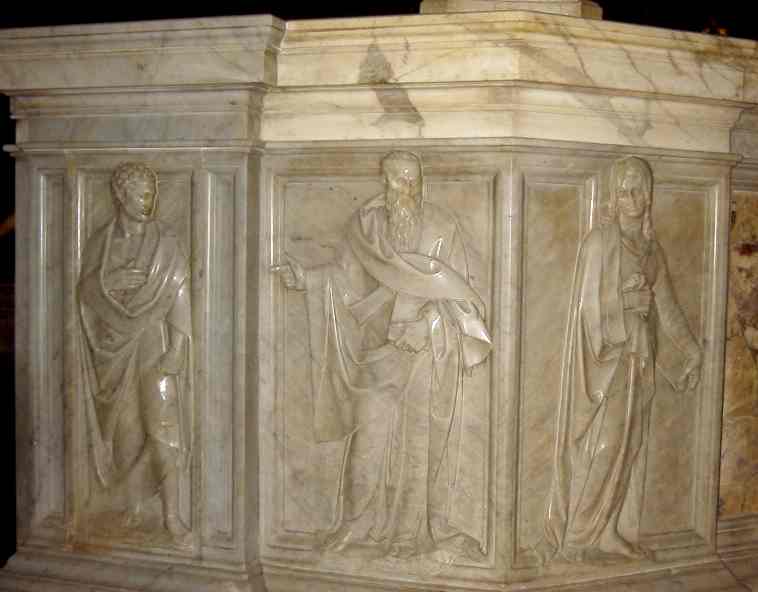
These are by another of the mob of Florence sculptors called Bandinelli. They seemed to have an endless supply of these guys during those days.
From the transept, the three short arms of the Latin cross radiate into separate apses, each containing five altars each, in case the Florentines wanted a mass demonstration.

Between two of these "chapel pods" is a sacristy where one of the Medici fled to escape a failed assassination attempt during the consecration of the mass. (They did kill his younger brother but I'm not even going to talk about mass murder.) The surviving Medici locked himself behind the sacristy doors until help could come. Over these doors is a beautiful terra cotta lunette done by the same artist who made those doors (Luca della Robbia
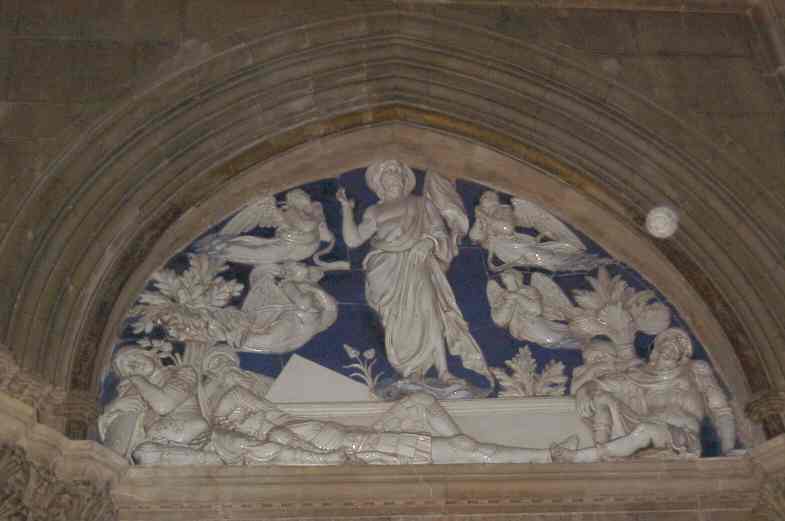
Before we discuss the dome, let's go outside and walk around the building. You will see a little of the dome from this picture but mostly you will see the rhythm of the South wall.
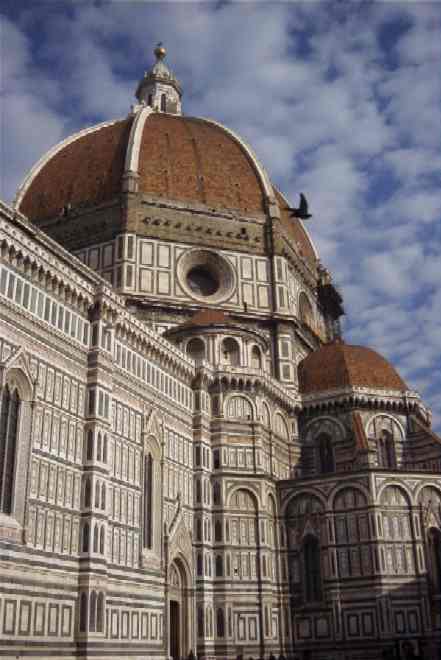
This view of the south side appears as we walk from the front (which is the west façade since almost all cathedrals west of Jerusalem face toward that city): Notice the inlaid patterns of marble (called marquetry), the pointed Gothic windows. What is hard to see here is the massive size of this wall. As you keep walking, you approach the dome from the outside. The bottom part is called the drum since it's a huge bass drum laying down. It was going to have a gallery around it (in fact a part of that gallery was built) but Michelangelo called the idea stupid 8 years after the construction began and the architect dropped the idea. (Was this before or after Michelangelo became the chief architect for St. Peter's? Perhaps there was a conflict of interest here).
Of even more interest was the faith of these people in putting up a drum 150 feet across without anyone knowing how to put a top on it for over a 100 years. We'll get to how Brunelleschi solved this problem of the great missing roof on our next web page. The dome is massive and dominates the city. Almost anywhere in the tourist section of North of the Arno river, you can look up and see it and find your way to where you want to go. It is still a landmark building.
>Here's a closer view of the south side:
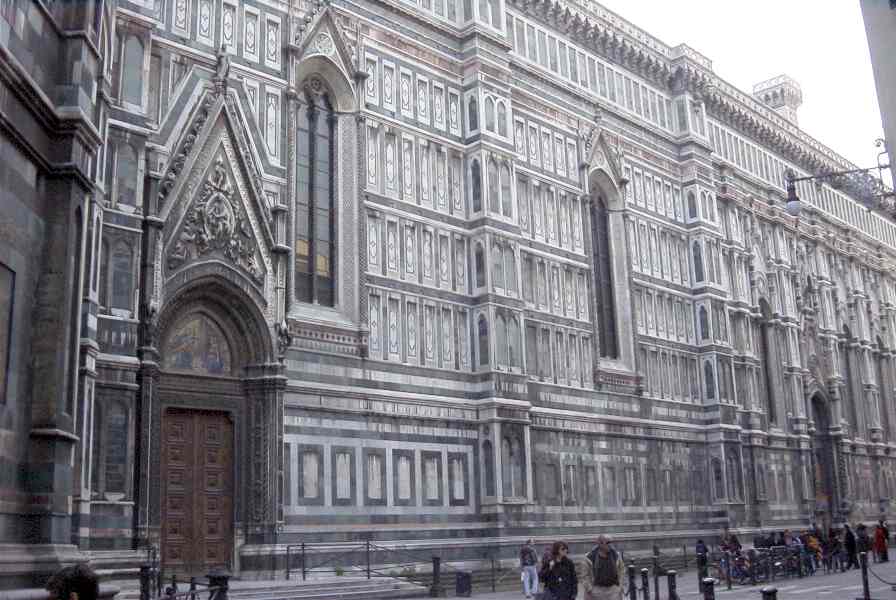
Walking around the back and to the North side, you see the Mandoria Door (so called because of the oval "Mandoria" of the Virgin Mary of the Assumption by Nanni di Banco in the early 15th century. Below it is a mosaic dating back to 1490 by Domenico Ghirlandaio. As you can see from this photo, the North side of the cathedral is pretty dirty, however, and in need of cleaning.
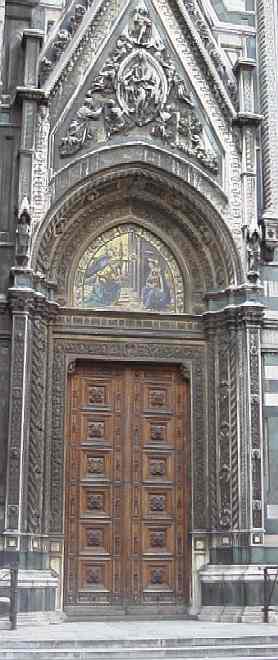
But the most fun was the long flight up the 463 stairs to the Dome. At the top, we went outside and took several pictures of Florence and the Tuscany countryside. Please join us by clicking here.
Are you a geek? Then you probably want a meaningless distraction rather than this art stuff. If so, read about the Foucault's Pendulum experiment conducted in the cathedral in 1977 to mark it's 700th anniversary.
Where do you want to go today? Here's a few choices:
